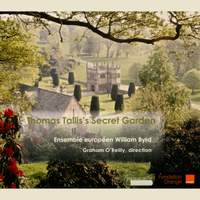Recording of the Week,
Thomas Tallis's Secret Garden
When Thomas Tallis died in Greenwich in 1585 he had spent close to fifty years serving as a composer and musician at the English Chapel Royal. Now you might have thought that such a position would have brought with it a stability and continuity which would have allowed him to hone his technique and develop stylistically as he wished. As it turned out, this period of British history was one of the most tumultuous of all times – Tallis serving under four different monarchs (Henry VIII, Edward VI, Mary I, and Elizabeth I), each one insisting on imposing their own different beliefs on the country. Passionate religious arguments and high political drama followed.

I’ve been reading about and listening to a lot of Tallis this week, as my father has just released a new disc of his works intriguingly titled ‘Thomas Tallis’s Secret Garden’. It is remarkable how Tallis’s style and content was determined by the wishes of the monarch at the time. Early in his career for example the large and ambitious antiphons perfected by Tallis’s predecessors Ludford and Taverner were still popular and this grandiose and florid style was adopted by Tallis in many of his earliest surviving works such as Salve intermerata. However, towards the end of Henry VIII's reign, with the split from Catholic Church in Rome, a new style of composition was demanded and in 1543 Archbishop Cranmer called for music “not full of notes, but as near as may be, for every syllable a note”. This was further enforced with the accession of Edward VI in 1547, and Tallis’s compositions from this period show a new simplicity and lucidity in style.
It was all change again in 1553 when the Catholic rite was restored on the accession of Queen Mary I. Tallis returned to the large-scale manner of composition again, and produced some of his most sumptuous works, including the six-voice Marian antiphon Gaude gloriosa Dei mater, a sample of which I have included below. It was short lived though as Mary's death in 1558 saw the return to the Anglican church with the accession of Queen Elizabeth I. The music of the new Anglican church was of limited interest, intentionally so, and unless a lot of manuscripts have gone missing it seems that Tallis had largely lost interest in setting music for the English service after 1559.
Instead, compositions from the last part of his life show a mature, restrained style, with an often-sombre atmosphere and imitative techniques imported from the Continent. Today, works from this period like the two sets of Lamentations of Jeremiah and the 40-part motet Spem in Alium are some of Tallis’s most popular works, and I think this is probably because we hear more emotion in his works from this period than we do in his earlier works.
Tallis was a humble, unassuming man, who avoided religious controversy, and was undoubtedly deeply respected by all four monarchs for whom he worked. His music was therefore his means of expression – his real secret garden.
My father’s new disc (which I mentioned above) uses one-voice to a part and achieves a chamber-like atmosphere which suits this style of polyphony perfectly. The voices are pure and glide peacefully amongst each other. The balance is excellent and the recording captures the warmth of the acoustic as well as the clarity of the singers’ voices superbly. It is all sacred music sung in Latin: there is a mixture of early, mid and later works included so it is a good way to hear for yourself some of the stylistic differences discussed above. I’ve put a link to the second part of the Marion antiphon Gaude gloriosa Dei mater below to give you an idea.
Available Formats: CD, MP3, FLAC



